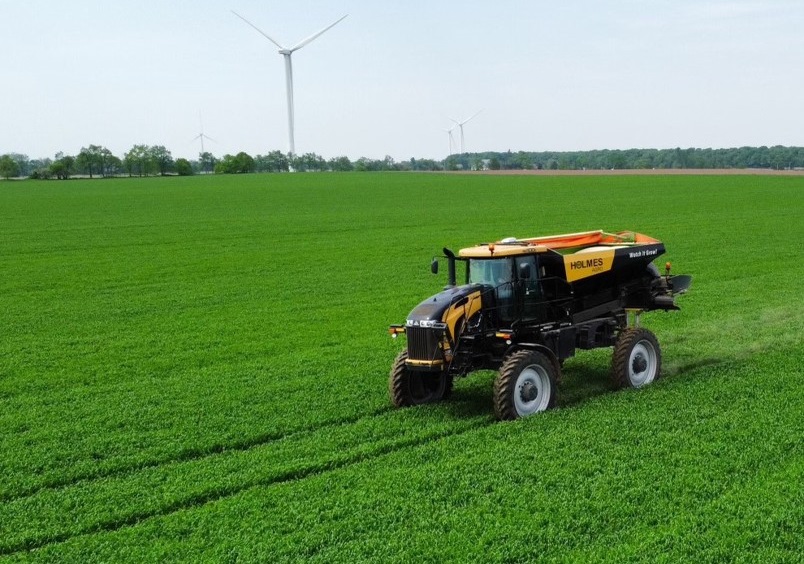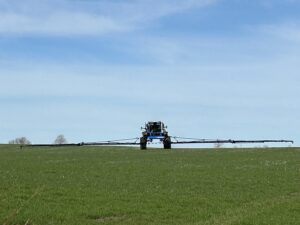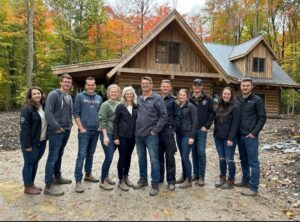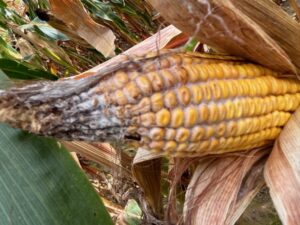4R in the field
REAPING THE BENEFITS

4R NUTRIENT STEWARDSHIP (RIGHT SOURCE, RIGHT RATE, RIGHT TIME AND RIGHT PLACE) is a well-known, well-respected and growing initiative in Ontario and across Canada.
Of course, many of its recommended practices, from split nitrogen application to to side-dressing corn, have been used by Ontario grain farmers for many years, but understanding and applying this broad science-based paradigm has helped participants better hone in on fertilizer use in a more strategic and effective ‘big picture’ way. As explained by Fertilizer Canada, which promotes 4R from coast to coast, participation “provides an economic benefit to growers by ensuring the fertilizer they apply makes it into the crop instead of being lost to the environment.”
Laura Shaw, certified crop advisor with 4R-certified Holmes Agro in Orangeville, notes that her conversations with growers about the program are centred around soil health and environmental benefits. “Farmers have always been stewards of the land,” she observes. “The 4R program is putting a name, procedure and measurability to the principles that have been used in Ontario agriculture for years.”
Lisa Ashton, environment and sustainability lead at Grain Farmers of Ontario, explains that the 4R program includes a third-party audit of agri-retailers’ 4R training, recommendations to farmers, implementation of the 4R principles and documentation. Unique in Canada, the audit process of the certification program that occurs in Ontario, says Ashton, “builds an additional layer of rigour and credibility.”
Continual evolution is another 4R hallmark, with ongoing studies ensuring the dissemination of the most up-to-date guidance. Grain Farmers of Ontario supports ongoing 4R research.
WHAT YOU NED TO KNOW
- The 4R Nutrient Stewardship refers to the right fertilizer applied at the right rate, the right time, and the right place.
- Fertilizer Canada promotes 4R awareness across Canada. In Canada, the 4R certification program is unique to Ontario.
- Working with a crop advisor at a 4R-certified retailer, participating farmers will create a nutrient plan and conduct soil tests.
- Participation in the program gives farmers a tailored plan specific to the conditions and variabilities on each farm, giving them tools to be economically, agronomically, and environmentally successful.
GETTING STARTED
Growers that work with a crop advisor at a 4R-certified retailer create tailored nutrient plans informed by soil tests. Soil testing is a critical first step that provides a multitude of benefits, explains Paul Johnston, general manager at Burlington, Ontario-based Sylvite, a 4R-certified retailer. “For growers who have been through the program, regular soil testing enables much more ongoing accuracy with matching nutrient application with yield goals, more insight into how to apply nutrients to maximize plant uptake, and so on,” he says. “All of this protects profitability.”
Growers with 4R-certified acres have assurance, says Shaw, that “the full value of nutrient applications are being accounted for in crop plans.” The crop plans are realistic and attainable, “tailored to the specific soil conditions/variabilities on each farm. This proactive crop planning helps assure that growers can continue to be economically, agronomically and environmentally sound.”
FERTILIZER APPLICATION
Among the application practices recommended on some farms through the 4R program, strip tillage provides many benefits to participants. It enables placement in a concentrated area with more effective plant uptake versus broadcast, but Johnston notes that it can also provide time management benefits for some growers. “You can do it in the fall or prior to planting in the spring, which is dependent on crop rotation,” he says. “Growers should also note it requires an investment in equipment, and it’s intended to be a long-term change.”
Growers see similar benefits in using the 4R-recommended practice of placing fertilizer in a starter band at seeding. In addition, variable rate application is also promoted through 4R, says Johnston. “There are capital costs, but as growers know, applying only what is needed to various areas of the field (again, soil testing is critical) means you’re applying nutrients in the higher-yielding areas of the field that will benefit more versus areas where yield may be lower for reasons other than nutrient availability,” he says, “all else being equal.”
PRODUCTS
Growers who use stabilizers with their nitrogen application reap broad environmental benefits and have the opportunity to use reduced rates from the higher end of the range. Reduced nitrogen losses result in more applied nitrogen being available to the plant, and stabilizers reduce its loss in three ways, through leaching, denitrification and volatilization. Some products also allow plants to receive a consistent nitrogen supply throughout all stages of growth, maximizing yields.
Shaw reports that in 2023, the Holmes Agro Team made an increased effort to communicate the importance of using a nitrogen stabilizer on urea that is being broadcast and not incorporated into the soil, especially when considering the 4R principles.
“This opened up great conversations of the potential economic benefits that come from protecting a high-cost input such as urea from unnecessary loss via volatilization, denitrification and leaching,” she explains. “Essentially the conversations are ‘we’re going to spend cents on the dollar to protect your investment of nitrogen while also meeting 4R principles, and achieving the overall goal of economically, agronomically and environmentally-sound fertilizer recommendations.’”
TIMING
Growers that follow the 4R principles also see many benefits from delaying some nitrogen application with side or top dressing or Y-dropping nitrogen into corn. This generally results in less nitrogen being applied to achieve the same yield.
Ensure with Y-drop application that your nozzles are positioned accurately to achieve proper fertilizer placement and prevent crop damage. In addition, optimal moisture conditions help facilitate the movement of the nitgrogen applied through this method into the root zone.
Johnston adds that some growers with 4R certified acres also benefit from splitting nitrogen application in a wheat crop. In addition, “many participants have also been able to reduce the amount of phosphorus applied in the fall,” he says. “Concentration of the phosphorus in a band reduces the amount of nutrient tied up in the soil. Use of soil amendments such as humic acid can help sequester phosphorus in the soil as well.”
COVER CROPS
Shaw adds that including cover crops in cropping systems in Ontario has been a great success story for 4R participants.
“Talking to growers, there is usually great feedback on improved soil health, improved weed control for future years and improved fertilizer use and efficiency,” she says. “Cover crops also allow for those fall fertilizer programs to have nutrients applied to an active crop versus the bare ground. As part of 4R, it is important to minimize potential loss through surface erosion and having cover crops in place significantly reduces this risk.” •











